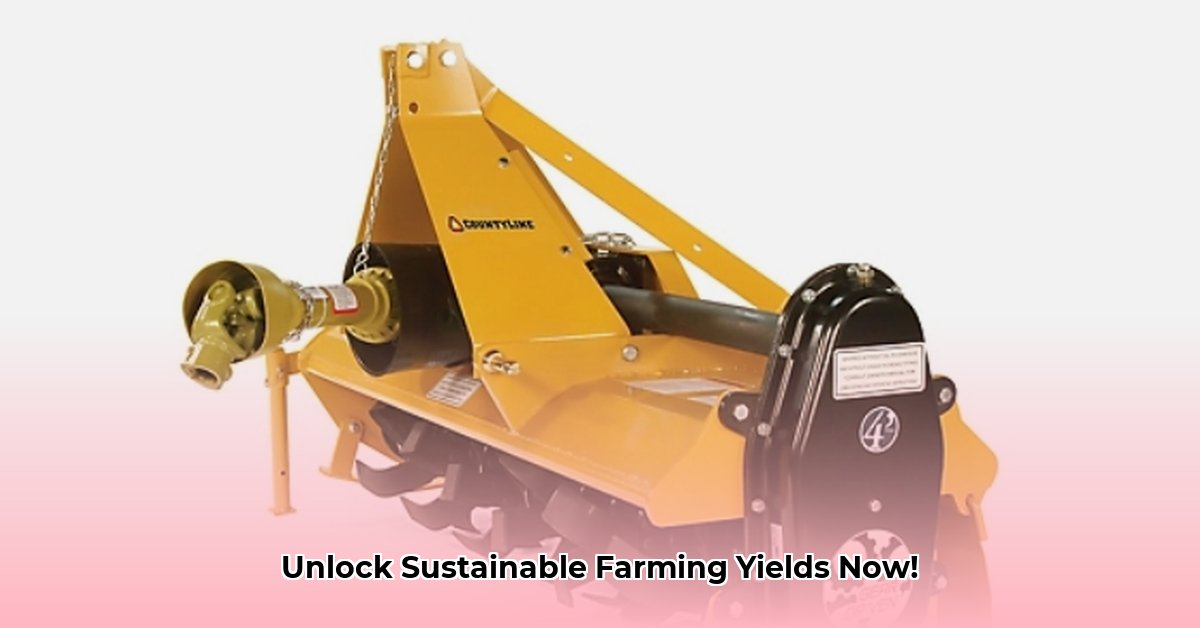
Garden Tillers Tractor Supply: Your Path to Sustainable Gardening Success
Sustainable agriculture isn't just a trend; it's a necessity for a healthier planet and food system. Choosing the right tools is key, and Tractor Supply's range of garden tillers offers options for various needs and sustainable farming goals. This guide will help you navigate the choices and implement sustainable tillage practices. For more information on Tractor Supply's tillers, visit Tractor Supply Tillers.
Understanding the Soil's Story: Why Sustainable Tillage Matters
Traditional tillage, characterized by deep plowing, can damage soil structure, leading to erosion, poor water retention, and reduced yields. It disrupts the delicate balance of the soil ecosystem, harming beneficial microorganisms crucial for nutrient cycling and plant health. These microorganisms act like a natural fertilizer system, breaking down organic matter into plant-available nutrients. Damaging this system is like disrupting a finely tuned machine; it may work temporarily, but its long-term efficiency declines significantly.
Sustainable tillage, conversely, focuses on minimizing soil disturbance. It's about working with the soil, not against it. This approach preserves soil structure, protects organic matter, and encourages the thriving of beneficial microorganisms. This leads to healthier, more fertile soil, ultimately resulting in improved crop yields and resilience. "Think of it as the difference between demolition and careful renovation," says Dr. Emily Carter, Soil Scientist at the University of California, Davis. "Sustainable tillage nurtures the soil's natural processes, leading to long-term benefits."
Don't you want to maximize your yields without sacrificing the health of your land?
Tractor Supply's Garden Tiller Lineup: Finding Your Perfect Match
Tractor Supply offers a variety of garden tillers, from lightweight models ideal for small vegetable patches to heavy-duty machines suited for larger properties. Factors to consider include tilling width, horsepower (an indication of power), and engine type (gasoline, electric). Multiple speed options including reverse gears can significantly impact user experience and efficiency, especially for larger gardens.
Choosing the Right Tiller: Matching the Tool to the Job
The ideal tiller depends on several factors:
- Soil Type: Heavy clay soils require more powerful tillers than lighter, sandier soils.
- Garden Size: Smaller gardens benefit from compact, maneuverable tillers, whereas larger plots need more robust machines.
- Tillage Depth: Sustainable practices often favor shallow tillage, minimizing soil disruption. Deep tillage can be detrimental to long-term soil health.
- Budget: Tractor Supply provides a range of tillers to accommodate different budgets.
Think of your soil as a living organism; selecting the right tiller is a critical part of its care.
Sustainable Tillage Techniques: Maximizing Your Yield and Soil Health
Effective sustainable tillage involves more than just the right equipment. Consider these practices:
- Reduce Tillage Frequency: Minimize soil disturbance to maintain soil structure and organic matter.
- Embrace No-Till or Minimal Till: These methods involve planting seeds directly into undisturbed soil. No-till farming significantly reduces soil erosion and enhances water retention.
- Cover Crops: Planting cover crops between harvests protects soil from erosion and improves fertility by adding organic matter and fixing nitrogen.
- Crop Rotation: Rotating crops prevents nutrient depletion and reduces pest and disease cycles.
Comparing Tillage Methods: Weighing the Pros and Cons
Different tillage methods offer varying benefits and drawbacks:
| Tillage Method | Pros | Cons |
|---|---|---|
| Conventional Tillage | Effective weed control, good seedbed preparation | Soil erosion, compaction, loss of organic matter, harms soil life |
| No-Till | Reduced erosion, better water retention, increased biodiversity | Potential weed issues, may require specialized equipment |
| Minimum Tillage | Reduces soil disturbance while offering some weed control | May not be as effective as conventional tilling for weed control |
How to Choose the Best No-Till Farming Techniques for Diverse Soil Types
No-till farming offers significant advantages, including improved soil health, water retention, and reduced erosion. However, the optimal approach varies depending on soil type and resources. A phased transition is often more successful than an abrupt switch. Careful planning and observation are key to success. And remember, integrating cover crops is highly beneficial.
Understanding Your Soil: The Foundation of No-Till Success
Before implementing no-till, assess your soil's texture, structure, and organic matter content. This information will guide your choice of techniques. "Soil testing is fundamental," emphasizes Dr. David Miller, Agricultural Extension Specialist at Purdue University. "Knowing your soil’s characteristics allows you to make informed decisions about sustainable tillage and maximize its potential."
No-Till Techniques: A Diverse Approach
Different no-till techniques cater to various needs and scales:
- Mulch Farming: Covering soil with organic matter suppresses weeds and enhances water retention.
- Cover Cropping: Planting cover crops improves soil structure and fertility.
- Direct Seeding: Planting seeds directly into undisturbed soil minimizes disruption.
- No-Till Drill Seeding: Specialized equipment is essential for larger-scale operations.
Remember, the best approach adapts to your specific conditions.
Transitioning to No-Till: A Phased Approach
A gradual transition allows for learning and adjustment. Start with a small area to test different methods before expanding. Regular soil testing helps monitor progress.
Choosing the Right Tools: The Role of Equipment
Selecting the right equipment aligns with your farming scale and no-till methods. Tractor Supply offers various tools to support sustainable tillage practices.
Challenges and Rewards: Navigating the No-Till Journey
While weed management and initial yield adjustments may present challenges, the long-term environmental and economic benefits of no-till farming are substantial. It’s a commitment to the health of your soil, your crops, and the future of sustainable agriculture.